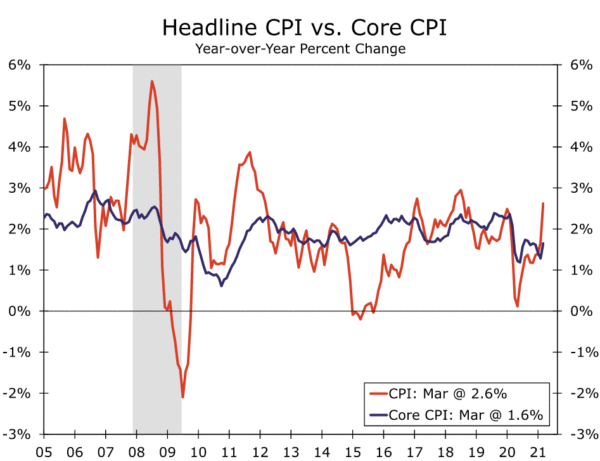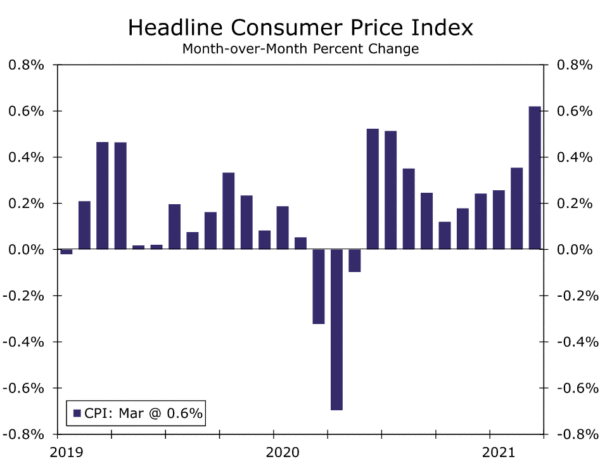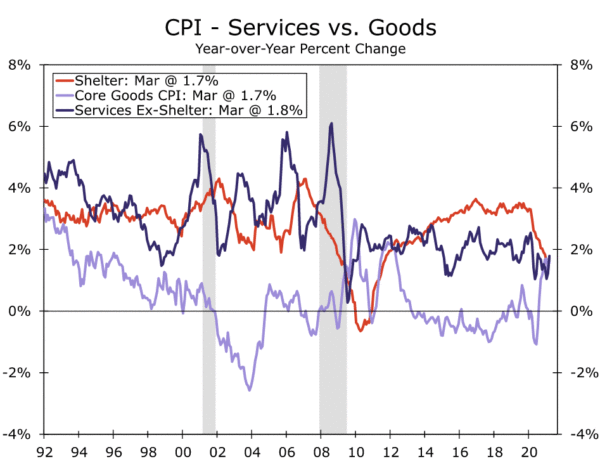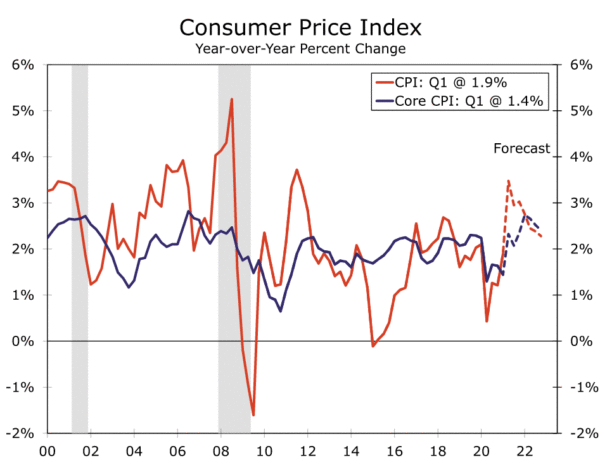Summary
The Consumer Price Index rose 0.6% in March. While low base comparisons from last year’s shutdowns helped drive the year-ago rate up to 2.6%, inflation has strengthened more recently. Core inflation rose 0.3%, with a pickup in recreation and travel-related services prices signaling the services economy is beginning to reawaken. That won’t deter the Fed, however, from maintaining its patient approach to policy as it awaits to see if rising inflation proves persistent.
Inflation Is Picking Up Now
Inflation heated up in March, with the Consumer Price Index (CPI) rising 0.6%. The year-over-year rate rose to 2.6% from 1.7% in February, helped by a low base comparison after a 0.3% monthly drop last March. The easy base comparisons from last year’s shutdown will continue over the next two months, including an even easier comp next month after the CPI fell 0.7% last April. But inflation is picking up now. Over the past three months, the CPI has increased at an annualized rate of 5.0%.
Energy was once again a major factor this month. Gasoline prices rose 9.1% in March to account for nearly half of the headline’s gain. The lift from energy prices is likely to fade over the next couple of months as oil prices have been relatively stable the past month and production rises in response to the firming demand outlook. But plenty of other items are poised to pick up the slack and propel inflation higher. That includes food, which moved up 0.1% last month. With food-related commodity prices sitting close to a seven-year high and more people venturing out to restaurants, prices for food at and away from home will likely pick up again in the coming months and continue to rise faster than core inflation.
Signs of the Services Economy Reawakening
Core prices are also firming. Excluding food and energy, core prices rose 0.3%, which pushed the year-ago rate to 1.6%. Here too momentum recently has picked up more than the 12-month change implies, with the core index strengthening to an annualized pace of 1.9% over the past three months. Core services led prices higher (+0.4%) as many spending categories constrained by restrictions over the past year began to demonstrate a pickup in activity and therefore some pricing power.
There were signs of life in the recreation services and travel sectors specifically. The price of admissions to theaters and sporting events rose 2.6%, which suggests the rapidly improving public health situation is leading to more in-person activities. Transportation services prices also moved higher (+1.8%), supported by a pickup in car rentals (+11.7%) and airfare (+0.4%) after sizable declines the two months prior. The rise in travel-related activity was also evident in lodging away from home prices (+3.8%) consistent with STR industry data that suggested a sizable pickup in hotel demand during the month.
Services inflation also received a lift from broader shelter costs, but we expect the boost to overall inflation will be greater in coming months. The owners’ equivalent rent (OER) component rose 0.2%, which is within its recent range. The more modest pickup suggests the 0.3% gain in February was partly due to monthly noise rather than the solid price gains in the purchase market over the past year beginning to filter through into the CPI. OER lags housing costs by about a year and a half, so prices are positioned to firm and provide a meaningful lift to core prices in coming months since OER represents 30% of the core index. Rental prices rose 0.2% for the second consecutive month.
After slipping last month, core goods inflation rose edged up 0.1%. Price gains among categories were mixed with recreational goods (-0.2%) and apparel (-0.3%) prices moving lower, and household furnishings (+0.4%) and transportation goods (+0.2%) prices higher. New auto prices were flat in March, but with production largely disrupted by semiconductor shortages and strong demand, prices will likely move higher in April. In fact, this is a general theme we expect to affect overall goods prices this year. Consumers are flush with cash which should lead to continued demand for goods even as the services economy reopens. Strong demand met with supply disruptions to production and manufacturing should put upward pressure on goods prices this year.
Higher, but for How Long?
In short, the pickup in inflation is attributable to more than just last spring’s low base comparisons. The economy’s full reopening at a time when households are flush with cash has created a wave of demand. Across the supply chain, there is a struggle to keep up, which is giving a wide range of businesses something they have not seen in more than a decade: pricing power.
As we have said before, inflation is a process. Whether near-term price hikes keep inflation higher even after the initial itch is scratched for services like travel and supply chains adjust will depend on inflation expectations. Consumer inflation expectations have moved higher over the past year, but are still low compared to the early part of the last cycle.
The Fed has made clear that it wants to see a sustainable pickup in inflation, and not a temporary increase. That evaluation will be difficult to make until late this year, after supply disruptions ease and the initial burst of activity as the economy fully reopens subsides. That will keep the Fed in wait-and-see mode for months to come. Our own view is that inflation is likely to strengthen further in the months to come, leading core CPI to reach a 2.7% year-over-year rate by the first quarter of 2022, but there remains a heightened degree of uncertainty around the outlook.

















